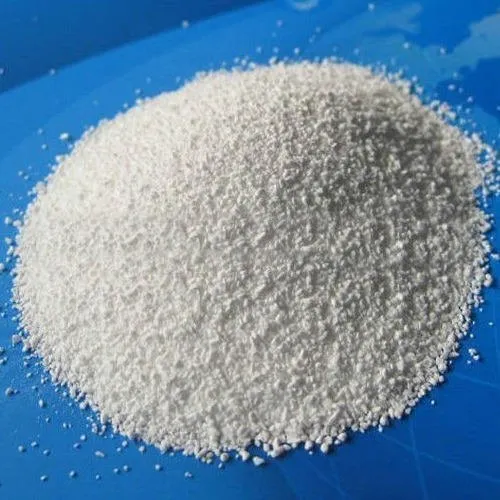19
2025
-
02
Calcium Hypochlorite Safety: Essential Guidelines for Handling, Storage, and Use
Calcium hypochlorite (Ca(OCl)₂) is a powerful chemical used primarily for water disinfection and pool sanitization. While it’s highly effective in killing bacteria, viruses, and algae, it’s crucial to understand the safety risks associated with its use and handling. Improper storage or mishandling of calcium hypochlorite can lead to dangerous reactions, chemical burns, or even fire hazards. In this blog, we’ll provide essential calcium hypochlorite safety tips for those who work with this chemical in water treatment, pool maintenance, or industrial applications. From safe storage practices to the proper handling techniques, we’ve got you covered.
Calcium Hypochlorite Safety: Essential Guidelines for Handling, Storage, and Use

Introduction: Understanding Calcium Hypochlorite Safety
Calcium hypochlorite (Ca(OCl)₂) is a powerful chemical used primarily for water disinfection and pool sanitization. While it’s highly effective in killing bacteria, viruses, and algae, it’s crucial to understand the safety risks associated with its use and handling. Improper storage or mishandling of calcium hypochlorite can lead to dangerous reactions, chemical burns, or even fire hazards.
In this blog, we’ll provide essential calcium hypochlorite safety tips for those who work with this chemical in water treatment, pool maintenance, or industrial applications. From safe storage practices to the proper handling techniques, we’ve got you covered.
What is Calcium Hypochlorite?
Calcium hypochlorite is a white granular or tablet form of chlorine compound that is commonly used as a disinfectant in water treatment and swimming pools. It contains about 65-70% available chlorine, which makes it highly effective in eliminating harmful pathogens in water. However, its high reactivity and strong oxidizing properties make it essential to handle with care.
Calcium Hypochlorite Safety Guidelines
1. Wear Appropriate Personal Protective Equipment (PPE)
Before handling calcium hypochlorite, ensure you are wearing the necessary personal protective equipment (PPE) to minimize exposure to the chemical:
- Gloves: Wear chemical-resistant gloves to protect your hands from contact with the chemical.
- Goggles/Face Shield: Always use safety goggles or a face shield to protect your eyes from splashes.
- Respiratory Protection: When handling large quantities or working in confined spaces, consider wearing a respirator to avoid inhaling harmful dust or fumes.
- Protective Clothing: Wear long-sleeved shirts, pants, and boots to minimize skin exposure.
2. Safe Storage Practices
Proper storage is key to reducing the risk of chemical reactions, spills, or accidents. Follow these guidelines for storing calcium hypochlorite:
- Cool, Dry Location: Store calcium hypochlorite in a cool, dry area away from direct sunlight and moisture. High humidity can activate the chemical and cause it to degrade.
- Avoid Heat Sources: Calcium hypochlorite is highly reactive with heat. Keep it away from heaters, radiators, or any sources of direct heat to prevent spontaneous reactions.
- Separate from Other Chemicals: Store calcium hypochlorite away from other chemicals, especially acids and organic materials, to avoid dangerous reactions. In particular, it should not be stored near ammonia, hydrogen peroxide, or fuel.
- Use Proper Containers: Store the chemical in airtight containers made of plastic or metal. Ensure the containers are clearly labeled and sealed tightly to prevent accidental spillage or exposure.
3. Safe Handling and Application
When using calcium hypochlorite for pool care or water treatment, it’s important to follow specific handling procedures:
- Do Not Mix with Other Chemicals: Calcium hypochlorite should never be mixed with other chemicals, especially acids, as it can produce dangerous gases or cause violent reactions.
- Add Slowly and Gradually: When adding calcium hypochlorite to water, do so gradually to avoid any sudden chemical reactions. Always follow the manufacturer’s recommendations for proper dosing.
- Avoid Inhalation: Do not breathe in the dust or vapors. Always handle calcium hypochlorite in a well-ventilated area to reduce inhalation risks.
- Avoid Direct Contact: If the chemical comes into contact with your skin or eyes, rinse immediately with plenty of water for at least 15 minutes. Seek medical attention if irritation persists.
4. In Case of Spill or Exposure
If there is a spill or exposure to calcium hypochlorite, immediate action is necessary to prevent harm:
- Spill Cleanup: If the chemical is spilled, avoid water or moisture exposure. Use an appropriate absorbent material like sand or vermiculite to soak up the spill. Dispose of the absorbent material properly.
- Skin or Eye Contact: If calcium hypochlorite comes into contact with your skin or eyes, rinse thoroughly with water. Seek medical help immediately if irritation persists.
- Inhalation: If you inhale calcium hypochlorite dust or fumes, move to fresh air immediately. If symptoms persist, seek medical attention right away.
5. Disposal of Calcium Hypochlorite
Proper disposal of calcium hypochlorite is crucial to avoid environmental damage:
- Do Not Dump into Drains: Never pour calcium hypochlorite into drains, sewers, or bodies of water. It can pose a threat to aquatic life and contaminate the environment.
- Check Local Regulations: Always follow local guidelines for chemical disposal. Some areas may have specific disposal procedures for hazardous chemicals like calcium hypochlorite.
Why Choose Aguachlon for Calcium Hypochlorite?
At Aguachlon, we understand the importance of safety when working with calcium hypochlorite. That’s why our products are manufactured to the highest quality standards to ensure safe handling, usage, and storage. Here’s why you should trust Aguachlon for your calcium hypochlorite needs:
- Reliable Quality: We provide food-grade calcium hypochlorite and pool-grade calcium hypochlorite that meets rigorous safety and quality standards.
- Comprehensive Guidelines: Our team provides clear instructions on proper handling, dosing, and storage to help you use the product safely and effectively.
- Expert Support: We offer expert advice and customer support to guide you in proper usage and safety procedures, ensuring you can get the most out of our products without compromising safety.
Conclusion
While calcium hypochlorite is an essential tool for water treatment and pool care, it must be handled with care to avoid accidents or harmful reactions. By following the proper safety guidelines, you can protect yourself and others while ensuring that your pool or water system remains clean and disinfected.
Choose Aguachlon for high-quality, safe calcium hypochlorite products that meet your disinfection needs while prioritizing your safety.
pool calcium hypochlorite safety,water treatment calcium hypochlorite safety,calcium hypochlorite safety,calcium hypochlorite handling,calcium hypochlorite storage,calcium hypochlorite precautions
undefined





